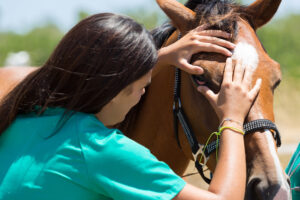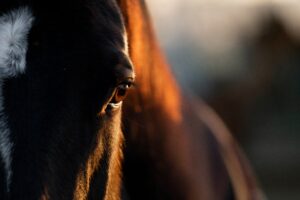Horses are known for their big, beautiful eyes. Shiny, soulful, each pair unique to the horse in question. Looking into your horse’s eyes is how you connect with them, how you get to know your animal and their one-of-a-kind personality.
So what do you do when those windows to the soul aren’t looking so bright and healthy?
Pink eye in horses isn’t so different from pink eye in humans. You may remember the ailment running rampant in your elementary school classroom, where kids aren’t the most careful about washing their hands and touching their eyes.
But how do horses get pink eye? And how do you get rid of this eye problem?
Read on to learn more about healing your horse’s bacterial infection.
What is Pink Eye in Horses?
The conjunctiva is the sensitive pink lining of the eyelids that covers the sclera, prevents microbes from entering the eye, and lubricates the eye with mucus and tears.1 Pink eye, also known as conjunctivitis, appears when the conjunctiva becomes irritated and inflamed.
If your horse has equine conjunctivitis, it means bacteria has been rubbed into their eyes. This was likely due to your fidgeting filly scratching their eye with their knee due to wind, dust, or flies.
What Causes Pink Eye in Horses?
Horses can be a lot like little kids: silly, playful, but with the tendency to get constant colds and infections. Your horse may be a fearsome beast of 1,000 pounds, but that doesn’t mean they aren’t also delicate and prone to illness like a bacterial infection.
Just like how horse scratches and scrapes are quite common, pink eye can have multiple causes. Some of these causes include:
- Wind and dust
- Allergens like pollen
- Face flies and other bugs
- Chemical irritants
- Deformities of the eyelid
- Eyelid wounds
- Parasites, such as habronema
- Tumors
- Heat and dry air
- Lack of tear production
- Viral or bacterial infections
- Trauma to the eye
While conjunctivitis in horses is not airborne, it is contagious. If your filly is feeling under the weather, keep them isolated from other horses to prevent contact infection.
How to Identify Conjunctivitis
Pink eye is obvious in humans, with our large white scleras: our eyes literally turn pink. It’s harder to spot in your horse when their beautiful dark irises take up most of the visible eye.
However, there are signs to look out for when concerned about equine conjunctivitis in your horse. Double check if your pony has:
- Overly weepy eyes
- The urge to shake their head often
- The tendency to scratch their face on their knees or other objects
- Eyelids that are squinting, irritated, swollen, or totally closed
- Discharge which can be clear, yellow, or mucusy
- Redness around the rims of the eye
- A sensitivity to dust
- An aversion to bright light
Any of these symptoms, especially when prolonged, can point to pink eye.2
Need to take a closer look to confirm redness and irritation? Keep in mind that if your horse is in pain, they won’t be thrilled about anyone poking around their face. But if you can get to the affected eye, try to get a closer look.
You can use your thumb and forefinger from one hand to gently spread the eyelids apart and better see signs of concern. If you see anything wrong with the horse eyeball itself, aside from irritated lids, call a veterinarian as soon as possible. A cloudy eyeball may be a sign of a more serious ailment.
Shorten Your Horse’s Pink Eye Recovery Time
It’s a terrible feeling when your horse is uncomfortable. You sympathize with your four-legged companion. When they’re in pain, it’s easy to feel helpless.
Thankfully, you can take an active role in your horse’s recovery. Most cases of pink eye are mild but some can progress and need veterinary attention. With the right treatment, infections can clear up within a few days of onset. To help address pink eye symptoms and get your horse cleared up fast, use Vetericyn Plus® Antimicrobial Eye Wash to clean and flush away debris. Our Antimicrobial Ophthalmic Gel can also be used to provide relief and reduce symptoms. Just be sure to keep the area clean and flushed regularly.
Vetericyn’s eye wash is a soothing solution to your pet’s eye problems. And its uses extend beyond pink eye, including:
- Flushing and cleaning the eyes
- Cleaning tear stains on eyes or cheeks
- Bringing relief to itchy, irritated eyes
- Soothing eyes suffering from allergies
- Cleaning discharge in and around eyes
What Will Treatment Look Like?
If you suspect your horse has pink eye, it’s still important to call a veterinarian. By doing so, you’ll be able to rule out other, more serious eye diseases. Once your vet confirms a diagnosis of conjunctivitis, they will likely prescribe your horse topical antibiotic cream, eye drops, or ointment to banish all signs of infection. In between applications, be sure to administer Vetericyn’s eye wash twice a day to keep the eye clean and clear during treatment.
If your vet prescribed antibiotics, be sure to run the entire treatment course, even if things seem to return to normal. Antibiotics work to eliminate the disease over time, and stopping them prematurely can result in some of the bacteria surviving and re-spreading. In turn, this can cause more damage to the eye.
Over-the-counter eye drops do not cure pink eye alone. However, they can be beneficial as a supporting element to antibiotics. With frequent eye flushing and proper care, your horse may experience significant improvement in just a few days.
How to Apply Eye Drops
Applying eye drops in our own eyes makes many of us flinch and twitch. To a horse who’s experiencing discomfort, anything going near their eye is a big red flag. To that end, you’ll need a strategy to apply eye drops.
The first tip is to always move slowly. To make applying eye drops easier, you’ll want to spend plenty of time interacting with your horse’s face, gently petting them and reassuring them. If you do this when they’re healthy, your horse will naturally be more at ease with this process.
If you can feel your horse’s hesitancy, rub the areas around both eyes. Give your horse treats when they allow you to get close.3
The easiest place to apply eye drops is the inner corner of the eye.4 Stand to the side of your horse’s head and move slowly while you work. If you need to, grab a helping hand to steady your steed.
If you’re applying ointment, or having a hard time with the corner of the eye, it may help to slide your hand under the cheek piece of your horse’s halter. That way, when their head moves, your hand is less likely to bump their eye.
With your other hand, gently pull down your horse’s lower eyelid with your thumb and apply a line of ointment. Your horse will blink the medication into place, and you’re good to go.
Preventing Future Outbreaks
Has your horse had pink eye more than once? Does it seem like a never-ending series of eye irritation, inflammation, and infections? If so, then you need to switch your eye care from defense to offense by preventing them from arising in the first place. It is also important to regularly bathe your horse and keep them out of the wind if possible. Debris and dust can easily get into the eye and start the problem.
Here are three important preventative measures you can take to reduce the chances of your horse developing conjunctivitis again.
#1: Utilize Antimicrobial Eye Wash & Ophthalmic Gel
If your horse tends to develop pink eye, it may be time to begin incorporating an eye wash and ophthalmic gel into your routine. That way, whether you have a particularly dusty ride, or the flies this summer are driving your horse crazy, you’ll be able to nip their pink eye in the bud.
When you see the warning signs of irritation—like your horse scratching or weeping—break out the antimicrobial eye wash and give your horse’s eyes a refreshing rinse. After using the rinse, apply the ophthalmic gel 2-3 times a day until the condition is no longer visible. They’ll be seeing clearly in no time, crust, dust, and pink-eye free.
It may even become a ritual they become comfortable with. Should pink eye ever occur, applying antibiotics will be even easier.
#2: Protect Your Horse With a Fly Mask
It’s difficult to pinpoint what exactly is causing conjunctivitis. But one of the most common culprits is flies, and the bacteria they carry with them when they land on your horse’s face and eyes.
To prevent an eye infection, fit your horse with a fly mask.5 This will protect them from any pesky bugs as well as kicked-up dirt and dust.
#3: Keep Their Stall Clean and Breezy
A clean stall means a happy horse. That goes double when your pony is prone to pink eye. Clear out manure and trampled hay, and replace still water as often as you can to prevent bacteria from building up. It also helps to keep a fan in the stall to blow away bugs and pollen.
Vetericyn: Clear Eyes, Happy Horse
An eye infection can be scary for both you and your horse. Luckily, Vetericyn is here to keep your horse’s vision sharp and ready to ride. Vetericyn Plus Antimicrobial Eye Wash and Vetericyn Plus® Antimicrobial Ophthalmic Gel are both an absolute must to keep in your stable.
Say goodbye to eye irritation, inflammation, and grime. Say hello to refreshed, beautiful eyes.
 Reviewed by Dan Richardson, Veterinarian
Reviewed by Dan Richardson, Veterinarian
Dan Richardson has been a practicing veterinarian for over 10 years. He specializes in surgery and orthopedics. Dan is originally from rural western Nevada and attended the University of Idaho for undergraduate study and Oregon State University for Veterinary School. The Richardson Family enjoys camping and spending time on the water fishing, paddle boarding, or digging their feet in the sand somewhere warm.
Sources:
- NCBI. Anatomy, Head and Neck, Eye Conjunctiva. https://www.ncbi.nlm.nih.gov/books/NBK519502/
- Equus Magazine. Eyeballing Conjunctivitis in Horses. https://equusmagazine.com/diseases/eyeballing-conjunctivitis-in-horses-8476
- Horse Nation. Right in the Eye: Tricks for Applying Eye Ointment. https://www.horsenation.com/2018/07/31/right-in-the-eye-tricks-for-applying-eye-ointment/
- Horse and Hound. Conjunctivitis: Cause and Treatment. https://www.horseandhound.co.uk/horse-care/vet-advice/conjunctivitis-cause-and-treatment-308522
- Kauffman’s. Horse Conjunctivitis Treatment. https://ka-hi.com/blog/animal-health/horse-conjunctivitis-treatment/#:~:text=Treating%20pink%20eye%20in%20horses,one%20cup%20of%20lukewarm%20water.

